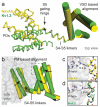The crystal structure of a voltage-gated sodium channel
- PMID: 21743477
- PMCID: PMC3266868
- DOI: 10.1038/nature10238
The crystal structure of a voltage-gated sodium channel
Abstract
Voltage-gated sodium (Na(V)) channels initiate electrical signalling in excitable cells and are the molecular targets for drugs and disease mutations, but the structural basis for their voltage-dependent activation, ion selectivity and drug block is unknown. Here we report the crystal structure of a voltage-gated Na(+) channel from Arcobacter butzleri (NavAb) captured in a closed-pore conformation with four activated voltage sensors at 2.7 Å resolution. The arginine gating charges make multiple hydrophilic interactions within the voltage sensor, including unanticipated hydrogen bonds to the protein backbone. Comparisons to previous open-pore potassium channel structures indicate that the voltage-sensor domains and the S4-S5 linkers dilate the central pore by pivoting together around a hinge at the base of the pore module. The NavAb selectivity filter is short, ∼4.6 Å wide, and water filled, with four acidic side chains surrounding the narrowest part of the ion conduction pathway. This unique structure presents a high-field-strength anionic coordination site, which confers Na(+) selectivity through partial dehydration via direct interaction with glutamate side chains. Fenestrations in the sides of the pore module are unexpectedly penetrated by fatty acyl chains that extend into the central cavity, and these portals are large enough for the entry of small, hydrophobic pore-blocking drugs. This structure provides the template for understanding electrical signalling in excitable cells and the actions of drugs used for pain, epilepsy and cardiac arrhythmia at the atomic level.
Figures





Comment in
-
Structural biology: Peering into the spark of life.Nature. 2011 Jul 20;475(7356):305-6. doi: 10.1038/475305a. Nature. 2011. PMID: 21776074 No abstract available.
Similar articles
-
Crystal structure of a voltage-gated sodium channel in two potentially inactivated states.Nature. 2012 May 20;486(7401):135-9. doi: 10.1038/nature11077. Nature. 2012. PMID: 22678296 Free PMC article.
-
Binding modes of μ-conotoxin to the bacterial sodium channel (NaVAb).Biophys J. 2012 Feb 8;102(3):483-8. doi: 10.1016/j.bpj.2011.12.041. Epub 2012 Feb 7. Biophys J. 2012. PMID: 22325270 Free PMC article.
-
Structural biology: Peering into the spark of life.Nature. 2011 Jul 20;475(7356):305-6. doi: 10.1038/475305a. Nature. 2011. PMID: 21776074 No abstract available.
-
Probing gating mechanisms of sodium channels using pore blockers.Handb Exp Pharmacol. 2014;221:183-201. doi: 10.1007/978-3-642-41588-3_9. Handb Exp Pharmacol. 2014. PMID: 24737237 Review.
-
Comparisons of voltage-gated sodium channel structures with open and closed gates and implications for state-dependent drug design.Biochem Soc Trans. 2018 Dec 17;46(6):1567-1575. doi: 10.1042/BST20180295. Epub 2018 Oct 31. Biochem Soc Trans. 2018. PMID: 30381338 Review.
Cited by
-
Extracellular protons inhibit charge immobilization in the cardiac voltage-gated sodium channel.Biophys J. 2013 Jul 2;105(1):101-7. doi: 10.1016/j.bpj.2013.04.022. Biophys J. 2013. PMID: 23823228 Free PMC article.
-
An evolutionarily-unique heterodimeric voltage-gated cation channel found in aphids.FEBS Lett. 2015 Feb 27;589(5):598-607. doi: 10.1016/j.febslet.2015.01.020. Epub 2015 Jan 27. FEBS Lett. 2015. PMID: 25637326 Free PMC article.
-
Voltage-gated sodium channels at 60: structure, function and pathophysiology.J Physiol. 2012 Jun 1;590(11):2577-89. doi: 10.1113/jphysiol.2011.224204. Epub 2012 Apr 2. J Physiol. 2012. PMID: 22473783 Free PMC article. Review.
-
Voltage-Gated Potassium Channels: A Structural Examination of Selectivity and Gating.Cold Spring Harb Perspect Biol. 2016 May 2;8(5):a029231. doi: 10.1101/cshperspect.a029231. Cold Spring Harb Perspect Biol. 2016. PMID: 27141052 Free PMC article. Review.
-
General mechanism of spider toxin family I acting on sodium channel Nav1.7.Zool Res. 2022 Sep 18;43(5):886-896. doi: 10.24272/j.issn.2095-8137.2022.185. Zool Res. 2022. PMID: 36052553 Free PMC article.
References
-
- Koth CM, Payandeh J. Strategies for the cloning and expression of membrane proteins. Adv Protein Chem Struct Biol. 2009;76:43–86. - PubMed
-
- Chaptal V, et al. Fluorescence Detection of Heavy Atom Labeling (FD-HAL): A rapid method for identifying covalently modified cysteine residues by phasing atoms. J Struct Biol. 2010;171:82–87. - PubMed
-
- Faham S, Bowie JU. Bicelle crystallization: a new method for crystallizing membrane proteins yields a monomeric bacteriorhodopsin structure. J Mol Biol. 2002;316:1–6. - PubMed
Publication types
MeSH terms
Substances
Associated data
- Actions
- Actions
- Actions
Grants and funding
LinkOut - more resources
Full Text Sources
Other Literature Sources
Molecular Biology Databases

